Today, let’s dive into the world of the ocean’s extreme divers, not humans, but amazing animals that can go super deep underwater. As we go deeper, it gets darker and colder, and the pressure really builds up. But some cool creatures have no problem with that, diving way down to find food or a safe spot away from predators. These daring dives take them to a hidden part of the ocean, showing us how tough and determined life underwater can be. So, are you ready to meet the world’s deepest-diving animals in the ocean today? Let’s dive in!
1. Baird’s Beaked Whale (Berardius bairdii) – 9,840 feet
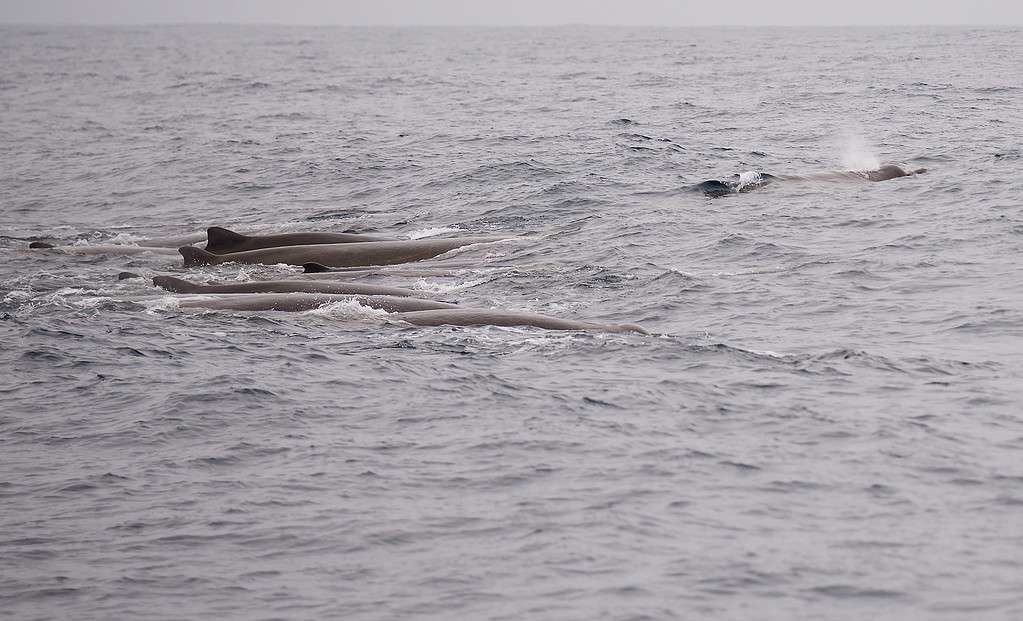
The deepest-diving animal in the world is the Baird’s beaked whale, which can dive up to almost 2 miles!
©Steve Peck / CC BY 2.0 – License
Whales are the undisputed champions of deep-sea diving, and among them, Baird’s beaked whales stand out. Being the largest in the beaked whale family, Baird’s beaked whales are experts at plunging into the ocean’s depths.
These sea giants have a long, slender build and a small, rounded dorsal fin located closer to their tail than their head. Fully grown females can measure up to 36 feet, whereas their male counterparts usually measure a tiny bit smaller at about 35 feet. Notably, adult whales of this species can tip the scales at nearly 26,500 pounds!
The head of Baird’s beaked whale is especially noteworthy, with a prominent forehead that sharply descends into a long, dolphin-like snout. The head emerges at a steep angle when they come up for air, showing off their unique facial features.
This whale’s diet includes a variety of fish, such as sardines and mackerel, along with crustaceans and sea dwellers like squid and octopus.
Though Baird’s beaked whales generally favor cold, deep waters extending below 3,300 feet, they’re occasionally seen closer to land, particularly underwater cliffs and continental edges. They’re often found around deep oceanic formations like canyons and underwater mountains.
How Deep Can the Baird’s Beaked Whale Dive?
As for their diving skills, Baird’s beaked whales don’t disappoint. An average dive might last anywhere from 11 to 30 minutes. However, some extraordinary dives have been clocked at over an hour. Typically, they dive down to around 3,300 feet, but the record-setting dive for this species reached an incredible 9,840 feet! That’s nearly 2 miles!
2. Cuvier’s Beaked Whale (Ziphius cavirostris) – 9,816 feet
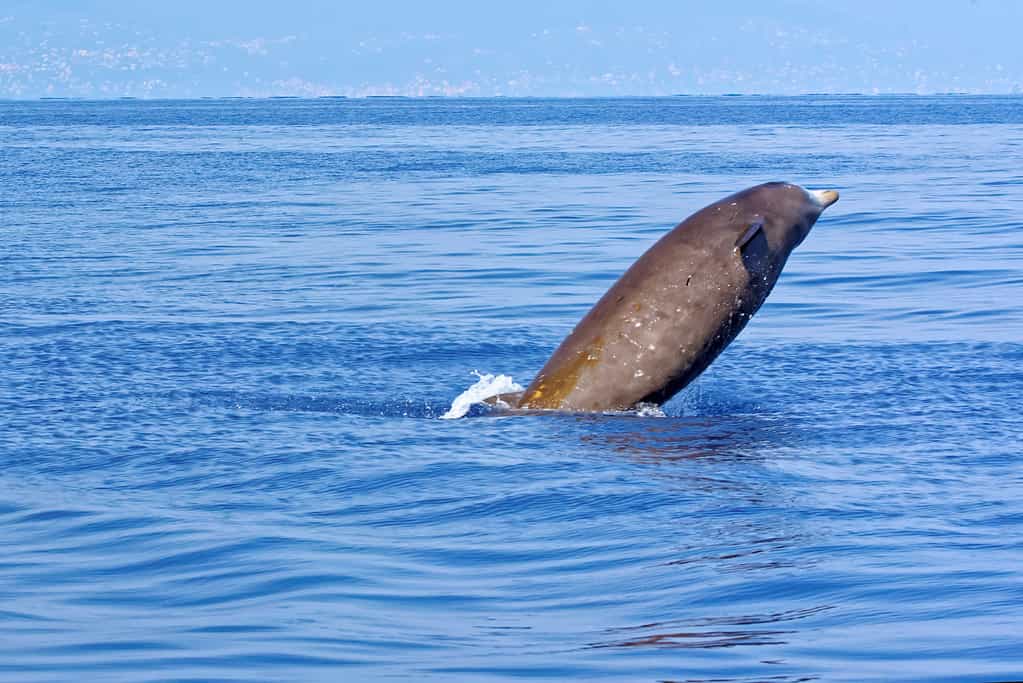
Another whale that makes the list of the deepest-diving animals is the Cuvier’s beaked whale, which holds a record of 9,816 feet.
©iStock.com/HeitiPaves
Cuvier’s beaked whale is well known for its exceptional ability to dive deep into the ocean.
These whales exhibit a long, sturdy body paired with a relatively compact head. They feature a short, unclear beak that tends to fade as they age. In mature males, the forehead, also called the melon, appears more pronounced and can even look bulbous. A unique mouthline curves along its length with a slight uplift at the end, giving it a resemblance to a goosebeak.
The Cuvier’s beaked whale’s skin showcases various colors, from dark gray to rusty brown or fawn, with lighter shades adorning the head and belly. Both male and female Cuvier’s beaked whales are around the same size. In general, these whales can stretch up to 15 to 23 feet long. The maximum recorded weight for these whales is a hefty 6,600 pounds, but they can way as “little” as 4,000 pounds.
Their diving prowess is truly remarkable, capable of making deep vertical plunges that can last a staggering 40 minutes. They also hold a noteworthy record for the longest dive by a whale, an astounding 222 minutes (3 hours and 42 minutes), which beats the previous record by an hour!
Being pelagic in nature, Cuvier’s beaked whales prefer the deeper waters beyond 1,000 feet and spread across offshore waters in all oceans, from tropical to polar regions. They’re flexible when it comes to food, mainly feasting on deep-sea squid, but they won’t say no to fish and some crustaceans.
How Deep Can the Cuvier’s Beaked Whale Dive?
The record for the deepest dive by a mammal goes to a Cuvier’s beaked whale that ventured 9,816 feet (2,992 meters or nearly 2 miles) beneath the ocean’s surface off the coast of southern California. For these whales, embarking on dives between 3,280 and 6,560 feet (1,000 and 2,000 meters) deep, lasting over an hour, is just part of their extraordinary undersea explorations.
3. Sperm Whale (Physeter macrocephalus) – 9,800 feet
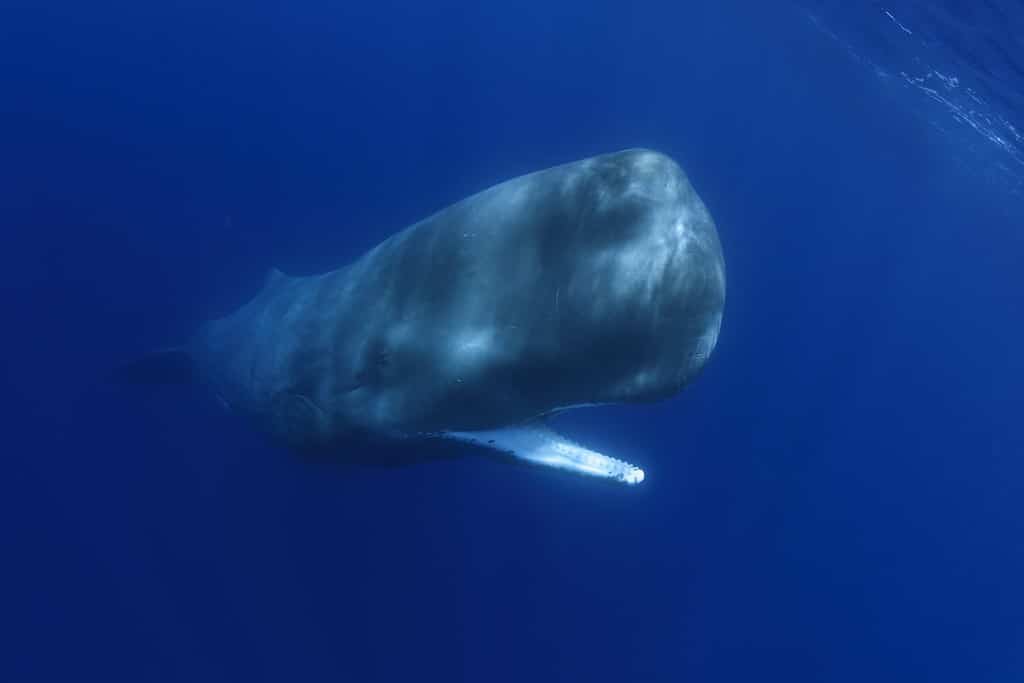
Coming in a close third is the sperm whale, a mammal that can hold its breath for up to two hours.
©Thierry Eidenweil/Shutterstock.com
The sperm whale is a remarkable marine giant known for its substantial size and ability to dive into the deep blue. Since 1970, this whale has been listed as endangered under the Endangered Species Act.
Sperm whales are easily identified by their oversized heads. These whales have tail lobes known as flukes and a distinctive spray pattern when they breathe. Holding the title of the largest toothed predator, males significantly outsize the females. Adult males are 30% to 50% longer and three times as heavy. The record-holder male sperm whale stretched an incredible 79 feet long! But as a general rule, these whales will measure around 49 to 59 feet.
With a specialized vocalization ability, sperm whales can belt out sounds reaching a whopping 230 decibels, earning them the crown of the loudest animals on Earth. Interestingly, their vocal patterns are a learned trait, varying from one clan to another.
Preferring the open, ice-free ocean waters beyond 3280 feet or 1000 meters deep, sperm whales are global citizens. They live in both temperate and tropical waters. Their dining menu predominantly features squid, including the giant and colossal varieties, but they also enjoy octopus, demersal rays, sharks, and other fish.
How Deep Can the Sperm Whale Dive?
Typically, their dives range between 980 and 2,620 feet, but they can plunge down to a breathtaking depth of 9,800 feet, making them one of the marine mammal kingdom’s deepest divers.
While on these deep-sea excursions, they can hold their breath for an astonishing two hours, although on average, their dives last about 45 minutes. They employ echolocation as a sonar to navigate and hunt in the deep, dark sea where sunlight barely reaches.
4. Elephant Seal (Mirounga) – 7,835 feet
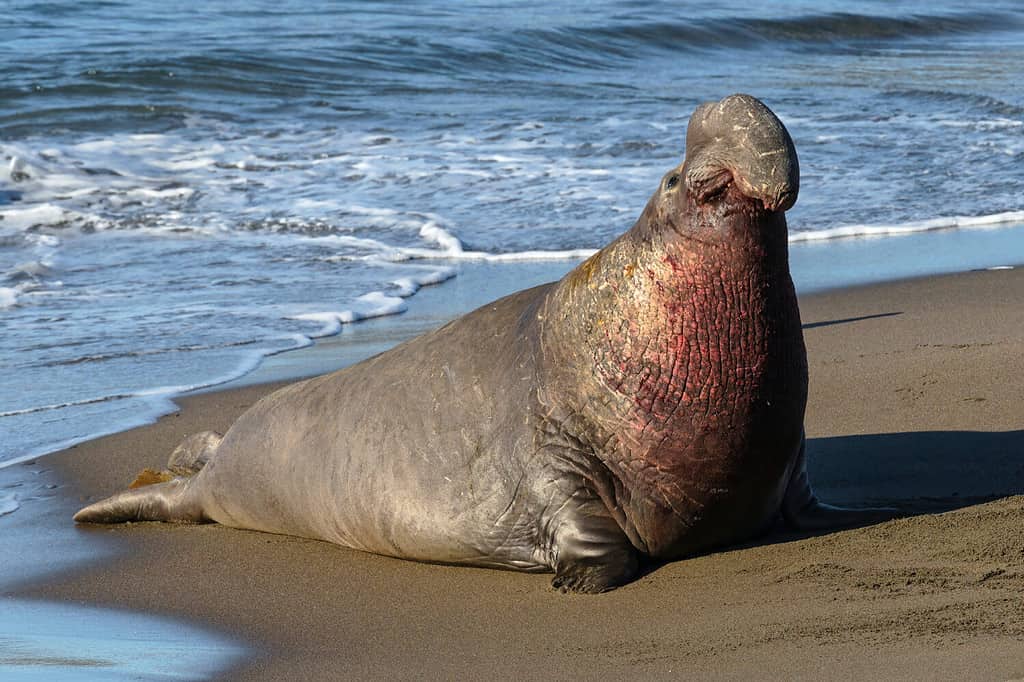
While northern
elephant
seals (pictured) can dive quite deep, southern elephant seals take the record for the deepest-diving seal.
©David Osborn/Shutterstock.com
In the world of deep-diving seals, the elephant seal is the unmatched champion.
Known for their large size and the males’ distinct, expandable nose that resembles an elephant’s trunk, elephant seals belong to the Phocidae family. While the northern species has a yellowish or gray-brown coat, the southern ones are more of a blue-gray hue.
Full-grown males can stretch beyond 13 feet and tip the scales at around 4,500 pounds. By contrast, females are smaller, generally measuring about 10 feet and weighing approximately 1,300 pounds.
Most of their time—about 80%—is spent on the ocean, with about 90% of that time spent underwater. These remarkable creatures can hold their breath for an impressive 100 minutes, setting the record for non-whale mammals. They’re also capable of covering 60 miles in a single day when venturing out into the open ocean.
As for their eating habits, elephant seals primarily feast on fish and squid. However, their menu includes sharks, rays, shellfish, krill, and even algae. Males and females both spend considerable time at sea hunting, although they take different migration paths to find their meals.
How Deep Can the Elephant Seal Dive?
These animals can nearly use up all the oxygen in their bloodstream, allowing them to stay submerged longer on the same breath. Astonishingly, they can plunge to depths reaching 5,090 feet, but the record belongs to a southern elephant seal that reached a depth of 7,835 feet!
5. Leatherback Turtle (Dermochelys coriacea) – 4,000 feet

One of the deepest-diving animals in the world is none other than the giant leatherback
sea turtle
!
©Stephanie Rousseau/Shutterstock.com
When it comes to reptiles that can dive deep, the leatherback turtle is unbeatable.
This is the world’s biggest turtle, distinguished by its unique, flexible shell. Unlike other turtles with hard, bony shells, leatherbacks have tough, rubber-like skin with seven vertical ridges. Their skin is primarily black, adorned with white, pink, and blue splotches, and their flippers lack claws.
These aquatic giants can be 6.5 feet long and weigh as much as 2,000 pounds.
While they spend most of their lives at sea, female leatherbacks come ashore to lay their eggs. These turtles are incredible travelers, with some covering distances greater than 10,000 miles each year as they move between nesting and feeding areas.
Leatherbacks inhabit both warm and moderate oceans worldwide. Their meals mainly consist of open-ocean invertebrates like jellyfish and sea squirts, but they also consume fish, crustaceans, algae, and drifting seaweed.
How Deep Can the Leatherback Turtle Dive?
What makes leatherback turtles amazing divers is their ability to go as deep as 4,000 feet and stay submerged for up to 85 minutes. This is made possible by their flexible shell and their unique ability to store a large quantity of oxygen in their blood and tissues.
6. Wedell Seal (Leptonychotes weddellii) – 2,000 feet
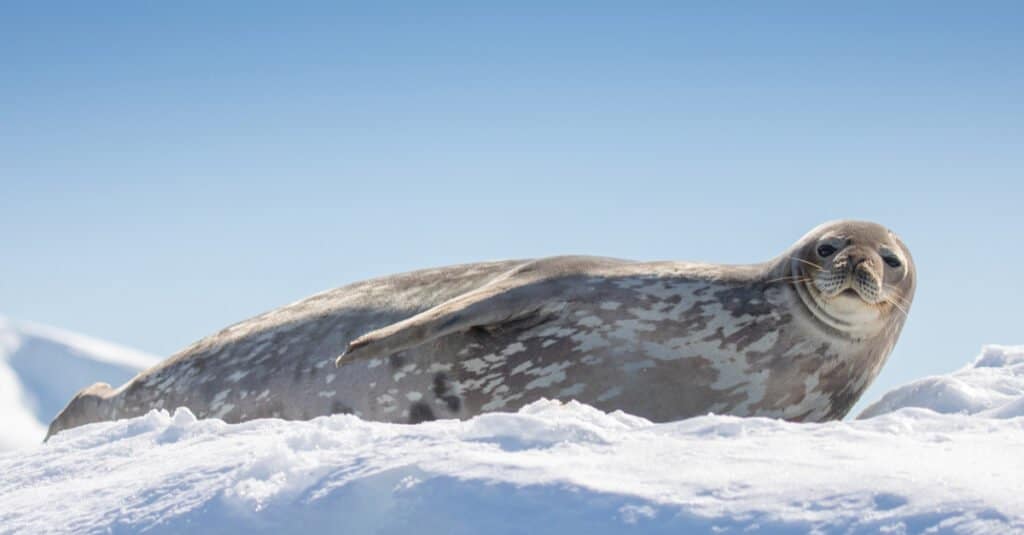
Weddell seals are impressive divers, reaching depths of up to 2,000 feet or more in search of food.
©Michelle Sole/Shutterstock.com
Even though the Weddell seal can’t compete with the elephant seal’s diving records, it’s still one of the ocean’s most impressive deep divers.
These seals have a stocky build, a small head, and a short, broad nose. They sport a dark gray or brown coat with a mix of lighter and darker spots on their underside, while their back is more of a silvery white. In proportion to their body, their front flippers are rather small.
With a weight reaching up to 900 pounds and a length of around 10 feet, Weddell seals are far from small creatures.
They usually gather near openings in the ice to breathe. During the frigid Antarctic winters, they prefer to huddle together in the water, exposing only their noses to avoid the winds.
These seals inhabit and breed in the southernmost regions of the world, specifically around Antarctica. They’re meat-eaters, consuming a varied diet that includes both open-ocean and bottom-dwelling fish, as well as squid, octopus, and shrimp.
How Deep Can the Weddell Seal Dive?
These seals commonly spend 20 minutes underwater in search of food, and the longest dive on record for this species is an impressive 96 minutes. They’ve developed efficient swimming techniques that help conserve oxygen, allowing them to extend their underwater adventures. This enables them to dive to depths exceeding 2,000 feet.
7. Emperor Penguin (Aptenodytes forsteri) – 1,751 feet

Emperor penguins are the deepest-diving birds in the world, reaching depths of 1,751 feet.
©Michel VIARD/ via Getty Images
No other birds can out-dive emperor penguins; they’re famous for their diving abilities!
They’re easily recognized by their black and white plumage, along with rigid black wings. These sizable birds can stand close to 4 feet tall and weigh between 70 and 90 pounds.
They’re sociable creatures, active during both day and night. These penguins enjoy the company of others while hunting or nesting. When the weather is good, they defend the small territories around them, but in colder conditions, they instead huddle for warmth.
You’ll only find these penguins in the wilds of Antarctica. They commonly nest and raise their offspring on “fast ice,” a type of floating ice shelf attached to land. Their primary food source is Antarctic silverfish, but they also consume other fish, krill, and squid.
How Deep Can the Emperor Penguin Dive?
These penguins usually dive to depths ranging from 300 to 600 feet, but some have been recorded diving an incredible 1,751 feet below the surface! They possess a unique ability to function with extremely low levels of oxygen in their blood, which helps them use oxygen more efficiently during their deep dives for food.
8. Thick-Billed Murre (Uria lomvia) – 690 feet
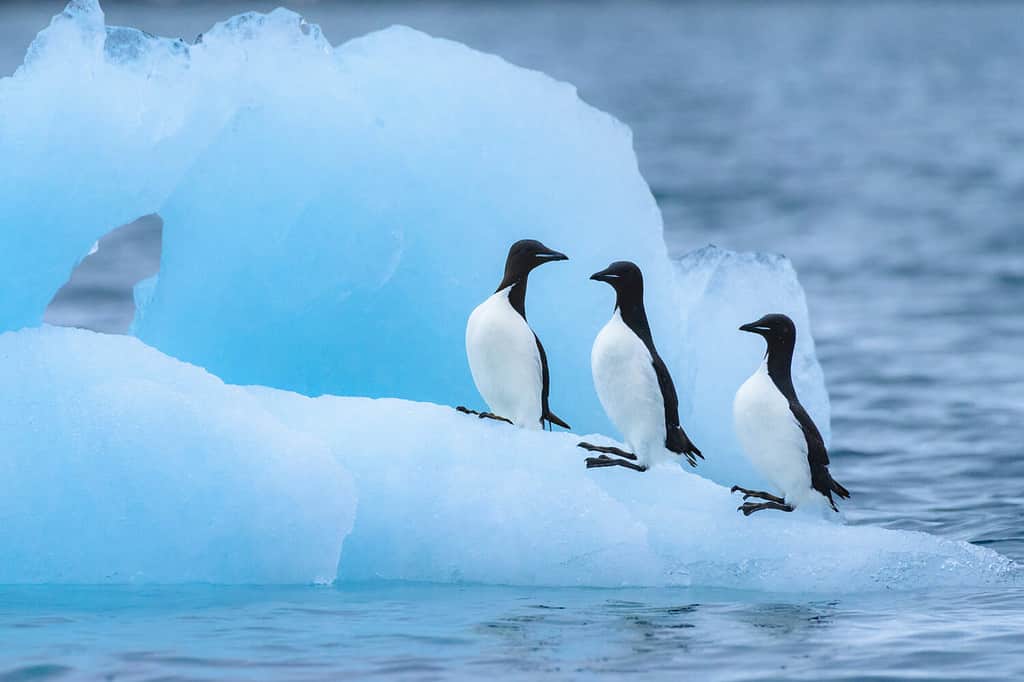
The deepest-diving flying bird in the world is the thick-billed murre, which makes it one of the deepest-diving animals in general.
©Danita Delimont/Shutterstock.com
While they don’t dive as deep as some other animals listed here , thick-billed murres are the deepest diving birds capable of flight. Recognizable by a white stripe on their beak and their black and white plumage, they’re not particularly large, ranging from 14 to 19 inches in size with a 30-inch wingspan.
Famed for their long lifetimes, these birds stay with a single partner and go to great lengths to feed their one chick at a time.
These birds mostly inhabit open waters, particularly in the icy regions of the High Arctic. When it’s breeding time, they opt for cliffside nesting spots and areas near sea ice where food is plentiful.
As for their diet, it’s mainly small fish but also includes a variety of other marine life like squid and shrimp. They usually hunt solo or in groups, often alongside birds of other species.
How Deep Can the Thick-Billed Murre Dive?
Don’t let their awkwardness on land fool you; thick-billed murres are surprisingly graceful swimmers. Their dives can reach depths of up to 690 feet, but they typically find their prey in shallower waters, roughly around 60 feet deep. What’s more, they usually consume their catch without resurfacing.
Summary of the Deepest-Diving Animals in the Ocean Today
| Rank | Animal | Dive Depth |
|---|---|---|
| 1 | Baird’s Beaked Whale | 9,840 feet |
| 2 | Cuvier’s Beaked Whale | 9,816 feet |
| 3 | Sperm Whale | 9,800 feet |
| 4 | Elephant Seal | 7,835 feet |
| 5 | Leatherback Turtle | 4,000 feet |
| 6 | Weddell Seal | 2,000 feet |
| 7 | Emperor Penguin | 1,751 feet |
| 8 | Thick-Billed Murre | 690 feet |
The photo featured at the top of this post is © Thierry Eidenweil/Shutterstock.com
Thank you for reading! Have some feedback for us? Contact the AZ Animals editorial team.







